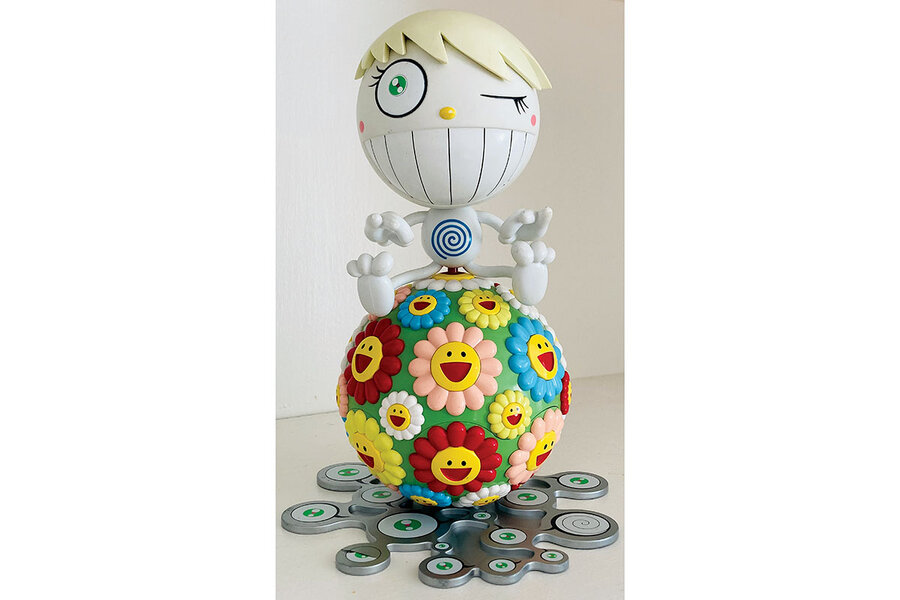Our knickknack was a running joke. Then we learned it was precious art.
Loading...
We Fullers are not a family of art connoisseurs. The least so was my late father-in-law, who, ironically, landed a job at an art college. Back in the 1980s, Papa – as we called him – transitioned from a long banking career to the director of finance for California Institute of the Arts.
Papa kept CalArts in the black by day, and at night he livened up the family dinner table with anecdotes about his new work environment. There was the student who took a plate from the cafeteria, put an apple and a banana on it, and balanced it on a post in the school parking lot for his senior project. And who can forget the young man who accepted his diploma in the altogether?
The artistic highlight of Papa’s job was the annual holiday gift he received from software entrepreneur and philanthropist Peter Norton. In 1988, Mr. Norton started a tradition of commissioning a contemporary artist to create an original, limited-edition work to give to a few thousand friends and members of the art world each holiday season. Mr. Norton was on the CalArts board, and Papa made the gift list – talk about fodder for Fuller dinner conversations!
Why We Wrote This
A story focused onWhen the true value of a piece of family art is discovered, our writer learns that the memories of shared experiences with family are priceless.
Each year’s piece was given a place of honor on the dining room table during the holidays: a distorted and chipped teacup, a plate with an image of Medusa rendered in marinara sauce, and mini snow globes disguised as salt and pepper shakers. The fake shakers made for a fun practical joke as we passed them to unsuspecting dinner guests.
The best of these gifts was Opal. At about 10 inches tall, with a head that’s a white plastic sphere, she has an oversize smile and long-lashed eyes. She has small rubber limbs and sits upon another sphere decorated with smiling daisies. The bottom sphere holds a mini CD that plays electronic music. Papa didn’t know what to make of Opal. He decided it would be funny to raffle her off to a family member. We threw numbers in a hat, and he pulled out a winner. He stipulated that the winner must bring Opal back the next Christmas and devise a new competition to pass her on.
My 6-year-old son, Brady, won Opal that first year. He displayed her proudly on his bedroom bookshelf, next to his Thomas the Tank Engine coin bank. The following Christmas, we drove Opal back to Los Angeles, where cousin Caleb won her in a tense pick-up-sticks game. We may have laughed at Opal’s appearance, but we are a competitive lot. Everyone was keen to win.
It went on this way for several years. Opal traveled home with the winner of a table tennis tournament, a rock-paper-scissors duel, and an epic croquet match.
Then in 2005, we got a shock. Papa saw a photo of Opal in The New York Times. The article was about Mr. Norton’s holiday gifts and said that Opal (who was actually named Oval) was designed by Takashi Murakami, a highly popular and successful artist. An Oval from the batch that had been produced as Norton gifts was sold at auction for $7,500. We felt like philistines.
Cousin Eli had Opal that year. Before bringing her to LA for Christmas, he crocheted her a protective hat and packed her in a padded case. We all examined her carefully and with relief declared that she was still in mint condition. We bantered about how to spend the money she would fetch if we sold her. A holiday cruise, perhaps? But the article, alas, had warned that selling would get you crossed off Mr. Norton’s gift list. And anyway, Opal was part of the family now. She was lovingly passed along in a poker game that year, and then by a four square tournament and a blindfolded Jelly Belly taste test on subsequent holidays.
Years later, the young children in our family have grown up. Some are married and have children of their own. Papa passed away. I recently looked up that old New York Times article and read that – according to project overseer Kris Karamitsu – Mr. Norton had endeavored with his holiday gifts “to make contemporary art accessible and understandable, through an actual object that people can live with,” according to Mr. Murakami.
We have lived well with Opal. She sits now on my daughter’s dresser. When I glance Opal’s way, I see Papa in her winking eye and smiling daisies. I see family tradition, spirited competition, and love. I think it’s fair to say we Fullers have become art aficionados.





